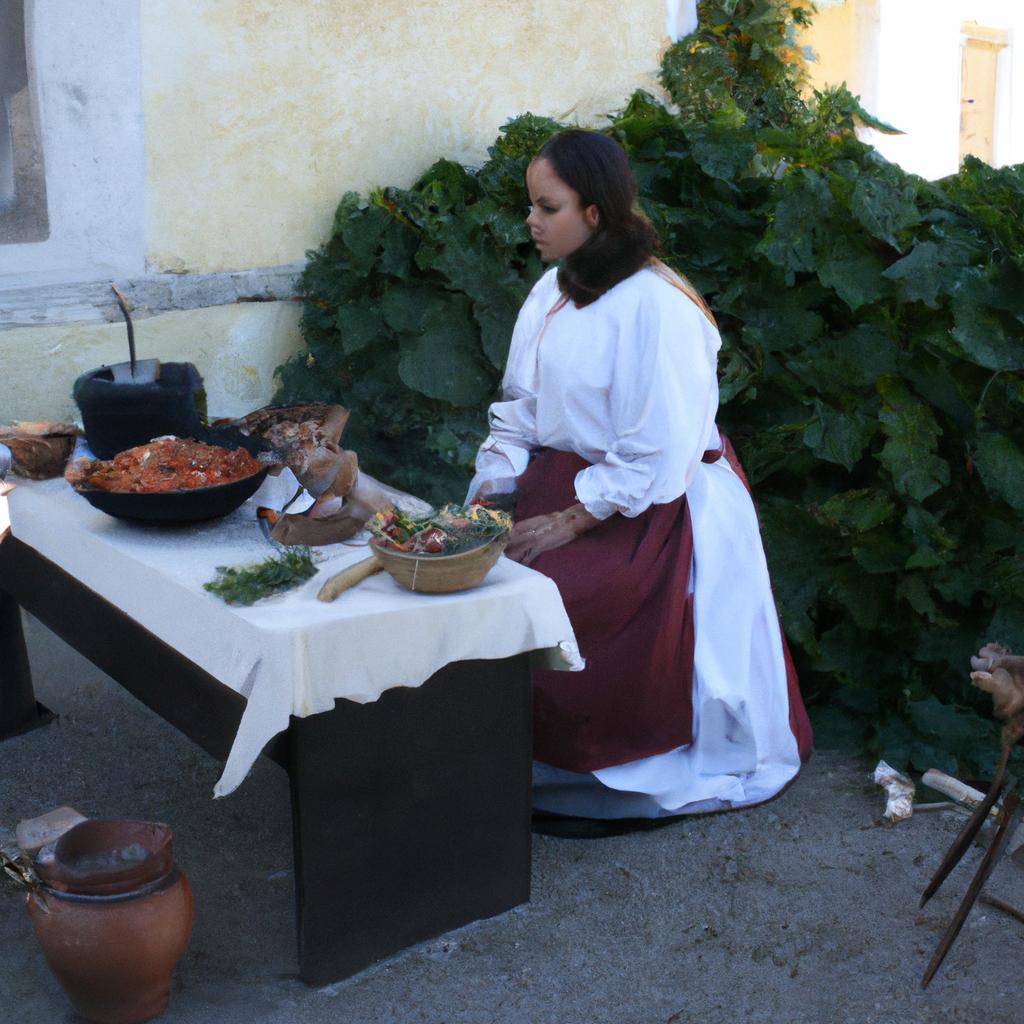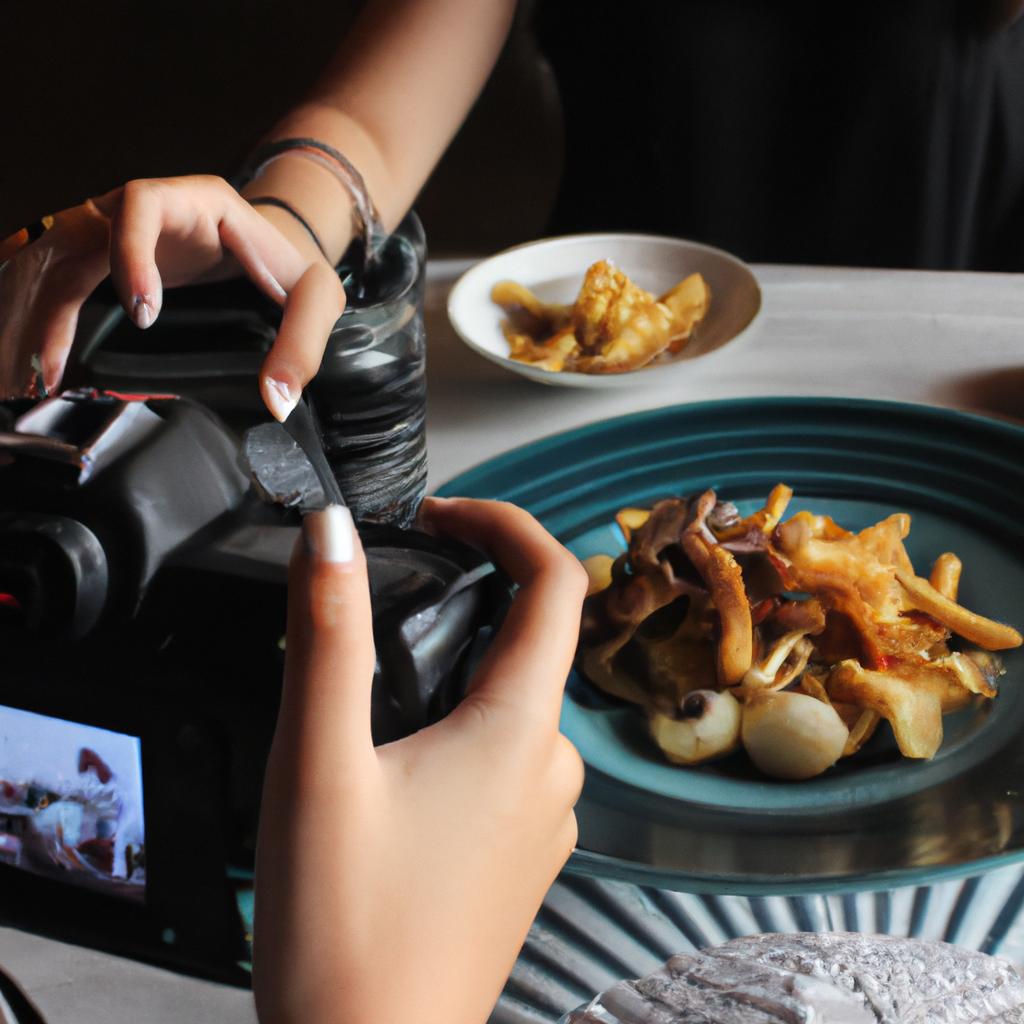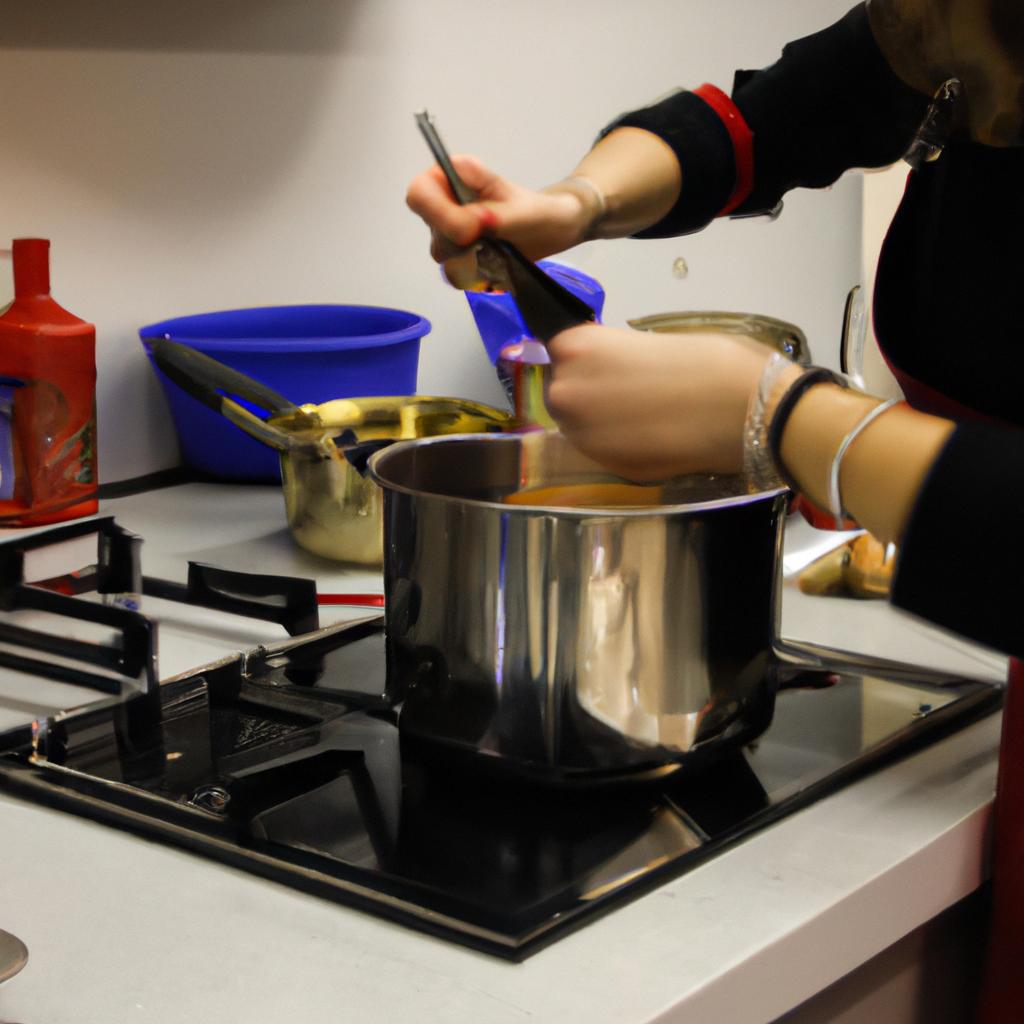In the world of culinary arts, mastering various kitchen techniques is essential for recreating and preparing delectable dishes. These techniques not only contribute to the overall taste and presentation of food but also play a significant role in enhancing the dining experience. For instance, imagine a chef meticulously using knife skills to expertly julienne vegetables, resulting in uniform cuts that not only cook evenly but also create an aesthetically pleasing arrangement on the plate. This example illustrates how kitchen techniques can elevate a dish from ordinary to extraordinary.
Understanding and implementing kitchen techniques require both knowledge and practice. From basic skills like chopping and slicing to advanced methods such as sous vide cooking or molecular gastronomy, each technique serves a specific purpose in transforming raw ingredients into exquisite creations. Moreover, these techniques enable chefs to manipulate textures, flavors, and aromas with precision, allowing them to unleash their creativity while maintaining control over every aspect of the cooking process.
The discipline required in honing one’s proficiency in kitchen techniques extends beyond mere technicality; it encompasses attention to detail, patience, and a deep appreciation for the artistry involved in culinary endeavors. By studying different approaches and experimenting with various tools and methods, aspiring chefs can develop their own style while adhering to time-honored principles passed down through generations. This commitment to mastering kitchen techniques not only ensures consistent and exceptional results but also fosters innovation and pushes culinary boundaries.
To embark on the journey of mastering kitchen techniques, aspiring chefs can start by familiarizing themselves with basic skills such as knife handling, sautéing, and grilling. These foundational techniques form the building blocks for more complex methods that require precision and finesse. As confidence grows, chefs can explore advanced techniques like braising, poaching, or pastry making, which demand a deeper understanding of ingredients and cooking principles.
In addition to hands-on practice in the kitchen, aspiring chefs can benefit from studying reputable cookbooks, attending culinary classes or workshops, and seeking guidance from experienced professionals. By immersing themselves in the vast world of culinary knowledge, they can gain insights into different cuisines, regional specialties, and contemporary trends. This continuous learning process helps chefs broaden their horizons while refining their technique repertoire.
Moreover, it is essential to cultivate an appreciation for quality ingredients and their characteristics. Understanding how different ingredients behave when cooked allows chefs to make informed decisions during preparation and create harmonious flavor profiles. By sourcing fresh produce, selecting premium cuts of meat or seafood, and utilizing seasonal ingredients whenever possible, chefs can elevate their dishes even further.
Ultimately, mastering kitchen techniques is a lifelong pursuit that requires dedication and a genuine passion for culinary arts. With each skill acquired and refined over time, chefs gain the ability to transform humble ingredients into extraordinary creations that delight both the palate and the eye. So whether it’s perfecting knife skills or experimenting with molecular gastronomy innovations, embracing the artistry behind these techniques opens up endless possibilities in the world of gastronomy.
Knife Skills
One of the essential skills in culinary arts is mastering knife techniques. Proper knife skills not only improve efficiency and productivity in the kitchen but also ensure safety and enhance the presentation of dishes. For example, imagine a chef skillfully slicing through vegetables with precision, creating uniform pieces that cook evenly and give a visually appealing final dish.
To develop proficiency in knife skills, it is crucial to understand the various cutting techniques used in professional kitchens. These include:
- Julienne: This technique involves cutting ingredients into long, thin strips resembling matchsticks. It is commonly used for garnishes or stir-fried dishes.
- Brunoise: In this method, ingredients are finely diced into tiny cubes around 1/8 inch on each side. Brunoise adds texture and flavor to soups, sauces, or salads.
- Chiffonade: Often applied to leafy greens like spinach or basil leaves, chiffonade entails stacking the leaves together, rolling them tightly, then thinly slicing across the rolled bundle. The resulting ribbons add an elegant touch to many dishes.
- Mincing: Mincing refers to chopping ingredients into very fine pieces using quick repetitive motions with a chef’s knife. It is frequently employed when preparing herbs or aromatics such as garlic and onions.
In addition to these techniques, it is important to consider proper knife handling and maintenance practices. Always hold the handle firmly with a secure grip while keeping fingers curled under and away from the blade’s path. Regularly sharpening knives helps maintain their sharpness for precise cuts while reducing the risk of accidents.
By honing your knife skills and understanding different cutting techniques, you can elevate your cooking abilities and create visually stunning meals. With practice and patience, these fundamental culinary arts skills will become second nature.
Moving forward to explore another aspect of culinary expertise—grilling techniques—we delve into methods that bring out unique flavors by harnessing heat from live fire sources.
Grilling Techniques
Transitioning from the previous section on knife skills, we now delve into the world of grilling techniques. Imagine this scenario: It’s a warm summer evening, and you’re hosting a backyard barbecue for friends and family. As the sizzling aroma fills the air, everyone eagerly waits to taste your perfectly grilled steaks or juicy burgers. Mastering grilling techniques not only enhances flavor but also adds an element of excitement to any gathering.
Grilling is more than just cooking food over an open flame; it involves finesse and precision to achieve optimal results. Here are some key techniques that will help elevate your grilling game:
-
Direct Heat vs. Indirect Heat:
- Use direct heat for foods that require quick cooking, such as thin cuts of meat or vegetables.
- Employ indirect heat when slow-cooking larger cuts or delicate items like fish, ensuring even cooking without charring.
-
Marinades and Rubs:
- Enhance flavors by marinating meats before grilling, allowing them to absorb a variety of seasonings.
- Dry rubs consisting of spices, herbs, and other ingredients can add depth and complexity to your dishes.
-
Temperature Control:
- Achieving the perfect temperature is crucial in grilling.
- Utilize a grill thermometer to monitor internal temperatures accurately, preventing undercooking or drying out your food.
-
Resting Period:
- Allow grilled meats to rest after cooking before slicing into them.
- This resting period enables juices to redistribute within the meat, resulting in juicier bites.
To further illustrate these points visually:
| Techniques | Impact |
|---|---|
| Direct vs. Indirect | Ensures proper cooking based on food type |
| Marination & Rubs | Infuses flavors |
| Temperature Control | Prevents over/undercooking |
| Resting Period | Enhances juiciness |
These grilling techniques, when coupled with an understanding of meat cuts and proper seasoning, will undoubtedly elevate your prowess in the culinary arts. Next, we delve into another cooking method that has gained popularity among professional chefs and home cooks alike: Sous Vide Cooking. By immersing food in a precisely controlled water bath, this technique offers unparalleled precision and consistency.
Sous Vide Cooking
Grilling Techniques have long been a popular method of cooking, known for imparting a distinct smoky flavor to various ingredients. Now, let us delve into the next section on Sous Vide Cooking, another innovative technique that has gained significant attention in recent years.
Imagine this scenario: you are hosting a dinner party and want to impress your guests with perfectly cooked steak. With traditional grilling techniques, achieving consistent doneness can be challenging due to variations in temperature control and timing. However, with sous vide cooking, precision becomes attainable.
Sous vide refers to the process of vacuum-sealing food in a bag and immersing it in a water bath at precisely controlled temperatures over an extended period. This gentle cooking method ensures even heat distribution throughout the ingredient without risking overcooking or drying out. For instance, by setting the water bath temperature to 130°F (54°C) and leaving a medium-rare steak submerged for two hours, you can achieve ideal tenderness consistently.
To further understand the benefits and considerations of sous vide cooking, consider the following:
- Enhanced Flavor Infusion: By sealing ingredients along with herbs, spices, marinades, or sauces before submerging them into the water bath, flavors penetrate deeply, resulting in enhanced taste profiles.
- Precise Doneness Control: Sous vide allows precise control over desired levels of doneness through accurate temperature settings and longer cook times.
- Minimal Nutrient Loss: As sous vide involves cooking within sealed bags without direct contact with boiling water or open flames, nutrients are preserved more effectively compared to other high-heat methods.
- Time Efficiency: While sous vide often requires longer cook times than traditional methods due to lower temperatures used; however, its hands-off nature allows for multitasking as there is no constant monitoring required.
Let’s take a closer look at these advantages through the following table:
| Advantages of Sous Vide Cooking |
|---|
| Enhanced Flavor Infusion |
In summary, sous vide cooking offers a precise and convenient way to achieve consistently delicious results. Whether you are a professional chef or an enthusiastic home cook, this technique opens up new possibilities for culinary creativity. In the subsequent section on Baking and Pastry, we will explore another realm of the culinary arts that involves precision, chemistry, and artistry in creating delectable pastries and desserts.
Baking and Pastry
Transitioning from the previous section on Sous Vide Cooking, let us now delve into another essential aspect of culinary arts – Baking and Pastry. To illustrate its significance, imagine a bustling bakery where skilled bakers craft delectable pastries that tantalize your taste buds with their enticing aroma and exquisite flavors.
Baking and pastry involve the precise combination of ingredients to create a wide array of treats such as cakes, breads, cookies, pies, and tarts. The artistry lies not only in the selection of high-quality ingredients but also in the mastery of various techniques that transform these raw components into mouthwatering delicacies. Here are some key aspects of baking and pastry worth exploring:
-
Temperature Control:
- Achieving optimal temperatures is crucial for successful baking.
- Precise control over heat distribution ensures even cooking throughout.
- Maintaining proper oven temperature prevents under- or over-baked goods.
-
Dough Development:
- Understanding dough consistency is vital when working with different recipes.
- Proper kneading techniques activate gluten formation for desired texture.
- Allowing dough to rest enhances flavor development and improved structure.
-
Leavening Agents:
- Incorporating leavening agents like yeast or baking powder creates volume.
- Timing plays a critical role in activating these agents during proofing or baking.
- Accurate measurements ensure consistent results in terms of rise and texture.
-
Decoration Techniques:
| Technique | Description | Example |
|---|---|---|
| Piping | Extruding decorative elements using a nozzle | Rosettes on cupcakes |
| Fondant Sculpting | Shaping pliable icing into intricate designs | A sculpted cake |
| Chocolate Tempering | Melting chocolate then cooling it to specific temperatures for smooth texture | Dipped strawberries |
| Sugar Work | Manipulating molten sugar into artistic patterns | Spun sugar for garnish |
In the realm of baking and pastry, precision is crucial. Each step – from measuring ingredients to monitoring cooking time – contributes to the final product’s quality. By mastering these techniques, bakers can produce delectable treats that delight both the eyes and taste buds.
Transitioning seamlessly to our next topic on Food Presentation, we explore how visual appeal enhances culinary experiences without compromising flavor or technique.
Food Presentation
Building upon the mastery of baking and pastry techniques, this section delves into the art of food presentation. By seamlessly combining aesthetics with culinary skills, chefs are able to elevate their dishes from mere sustenance to works of art that tantalize both taste buds and visual senses. Let us explore the key elements involved in creating visually pleasing presentations that enhance the overall dining experience.
Food Presentation: An Essential Ingredient for Culinary Excellence
To illustrate the importance of food presentation, consider a hypothetical scenario where two identical plates of pasta carbonara are presented side by side. The first plate is hastily assembled, resulting in a disarrayed pile of noodles topped with unevenly distributed sauce and garnish. In contrast, the second plate showcases meticulous attention to detail; each strand of pasta is perfectly intertwined, adorned with precisely placed bacon bits and finished with a sprinkle of fresh herbs. Without even tasting them, it comes as no surprise that diners would be more inclined to savor the dish thoughtfully arranged on the latter plate.
In order to achieve such visually captivating presentations, chefs employ various techniques and strategies:
- Balance: Striving for equilibrium between different components on a plate can create harmony and evoke satisfaction in diners’ eyes.
- Contrast: Skillful use of contrasting colors, textures, and shapes adds visual interest and depth to a dish.
- Proportion: Proper proportioning ensures that each element complements one another without overpowering or diminishing its counterparts.
- Plateware Selection: Choosing appropriate plates, bowls or platters can enhance the overall aesthetic appeal while also providing functional support for food arrangement.
Emotional Bullet List:
Creating stunning food presentations not only elevates your culinary creations but also evokes emotions in your audience. Consider these effects:
- Awe-inspiring displays can generate feelings of admiration and wonderment.
- Thoughtfully crafted presentations elicit excitement and anticipation before indulging in a meal.
- Beautiful aesthetics can convey a sense of sophistication and elegance.
- Well-executed food arrangements can invoke nostalgia or create new memories.
Emotional Table:
| Emotion | Effect |
|---|---|
| Admiration | Inspires awe and appreciation |
| Excitement | Generates anticipation |
| Sophistication | Portrays elegance and refinement |
| Nostalgia | Evokes sentimental feelings |
In summary, mastering the art of food presentation is vital for chefs aiming to create unforgettable dining experiences. By employing techniques such as balance, contrast, proportion, and careful selection of plateware, culinary professionals can transform their dishes into visually captivating works of art that evoke admiration, excitement, sophistication, and nostalgia among diners. In the following section on “Flavor Pairing,” we will explore how marrying different tastes can further elevate the overall sensory experience in gastronomy.
Flavor Pairing
Food Presentation plays a crucial role in the culinary arts, as it is the first impression that a dish makes on diners. It involves arranging and decorating food in an appealing and aesthetically pleasing manner to enhance its visual appeal. This section explores various techniques used in food presentation to create visually stunning dishes.
One example of a creative food presentation technique is the use of edible flowers to garnish desserts. For instance, imagine a velvety chocolate cake adorned with delicate rose petals and lavender buds. The vibrant colors and natural beauty of these edible flowers not only add an element of elegance but also enhance the overall dining experience for guests.
To effectively present food, chefs employ several key techniques:
- Plating: The arrangement of components on a plate should be balanced, ensuring that each ingredient can be tasted individually while harmonizing with others.
- Color: Using a variety of colorful ingredients creates visual interest and adds vibrancy to the dish.
- Height and Texture: Incorporating elements with different heights and textures adds depth and dimension to the presentation.
- Negative Space: Leaving empty spaces on the plate helps draw attention to the focal point of the dish.
In addition to these techniques, understanding flavor pairing is essential for successful food presentation. Pairing complementary flavors can elevate the taste profile of a dish, making it more enjoyable for diners. For example, combining sweet mango with spicy chili pepper creates a delightful contrast that excites both the palate and visual senses.
Table 1 below showcases examples of popular flavor pairings:
| Flavor Combination | Example Dishes |
|---|---|
| Sweet & Savory | Honey-glazed salmon |
| Spicy & Tangy | Thai green curry |
| Salty & Sweet | Salted caramel ice cream |
| Acidic & Fresh | Caprese salad |
Overall, mastering food presentation techniques allows chefs to create visually captivating dishes that engage and entice diners. By combining artistic plating skills with thoughtful flavor pairings, culinary professionals can elevate the dining experience to new heights.
Table 1: Examples of popular flavor pairings
 Refoksa
Refoksa



